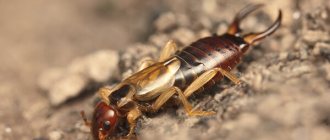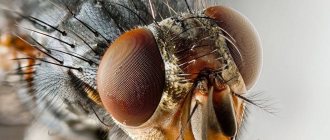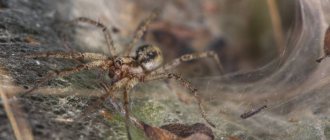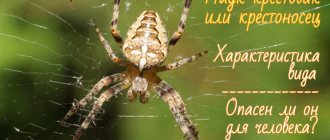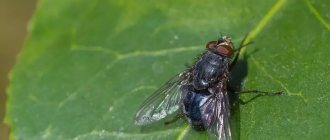How long do midges live?
Midges appear most often in old housing stock, but such insects can also be found in new apartments. Their lifespan is short, but the size of the colony does not decrease due to high fertility.
The fight against midges is often delayed due to the fact that adult individuals mature quickly and manage to lay a large number of eggs in a short time. They do not bite people, they annoy people solely with their presence.
Homemade
How long midges live in apartments depends on several factors:
- air temperature and humidity;
- availability of food (not relevant for everyone) and conditions for reproduction;
- methods of control used.
Under favorable conditions, some species can live up to 10-15 days. At the same time, the population will grow rapidly, since the period of pupa maturation will be reduced.
In nature
How long midges live on average in nature depends on their type and environmental conditions. This type of insect is a food source for many birds, so the expansion of the midge population in the wild is limited.
With the onset of cold weather, some species hibernate, which prolongs their life.
Midge pests live longer in the wild. The optimal temperature and humidity for most of them are greenhouses. In nature, these midges have the opportunity to choose the most suitable crops for reproduction.
For whiteflies, these are tomatoes, peppers, and eggplants. The longest life expectancy for such midges is in conditions of year-round closed ground (greenhouses).
Prevention
To prevent midges from appearing in your home, you must follow a small set of rules, namely:
- systematically carry out general cleaning and frequently take out the trash;
- store all food products only in the refrigerator, since midges do not develop in a cold environment;
- all fruits and vegetables brought into the house should be thoroughly washed with hot water to get rid of eggs;
- systematically clean the sewer and eliminate excessive moisture;
- get rid of spoiled food in a timely manner, and thoroughly wash the place where they were stored;
- properly care for house plants, change the soil on time and do not over-water it.
By following all the above rules, you will eliminate the possibility of midges appearing in your home and protect your life.
Video
Types of midges
In the apartment you can find the following types of midges: fruit flies, sciarids, butterflies, whiteflies. They are safe for humans, but can spoil plants and infect food with larvae.
Drosophila are small red midges that fly slowly, changing direction chaotically (moving in a straight line with sharp turns). Rotten, overripe vegetables and fruits are their habitat and reproduction.
They appear mainly in the kitchen near the sink, bucket, and vegetable drawers. They can reproduce on the rotting pulp of cacti.
Sciarids (detritus, fungus gnats) are translucent midges with a black body. They live in the top layer of soil of flower pots in rotten plant debris.
These midges breed especially actively on waterlogged, acidified soil under Saintpaulias (violets), orchids, and chrysanthemums. There are two ways to get into the apartment: with purchased soil or from the street (through open windows).
They multiply especially actively during cold weather, when the evaporation of moisture from the soil slows down.
Sewer midges (butterflies) are small butterflies resembling moths that live in rooms with high humidity. They often appear in houses with faulty sewerage, old pipelines, and damp basements.
People enter apartments through ventilation ducts and pipes . Eggs are laid on rotting plant debris. They fly slowly and over short distances.
They are usually seated on ceilings and walls. Some information sources contain information that butterflies carry dangerous diseases, but there is no official confirmation of this.
Whitefly (aleiroda) is a type of midge that parasitizes mainly greenhouse crops.
In apartments it appears with soil purchased for flowers or seedlings, with house plants or seedlings. Such midges rarely come in from the street through windows.
Use of folk remedies
Professional chemicals are considered the best way to get rid of small midges in a house or apartment. However, not everyone is ready to breathe in unknown substances, because their safety for people and pets remains in question for many. In this case, the owners prefer to use folk recipes, tested by people and time, which are guaranteed not to have any negative impact on the health of all residents of the house.
Help from essential oils
This is one option that will make the house unattractive to any type of insects, because they cannot tolerate many strong odors. For example, midges will definitely not like the aromas of the following essential oils:
- cedar, pine;
- vanilla, cloves, geranium;
- ylang-ylang, lavender, incense;
- lemon, tangerine, mint, tea tree;
- patchouli, wormwood, tansy, fir, juniper.
Oils are used in different ways. Some owners drip etherol onto lampshades or cold lamps, onto heating appliances, or spray solutions. Other owners prefer aroma lamps, while others place branches of fragrant plants or pieces of zest in their rooms.
It is believed that any method will bring results. However, this “essential” option can be used in one case: if there are no allergy sufferers in the house, small children or pets who are extremely sensitive to any strong aromas.
Making homemade traps
The most original method of dealing with tiny insects is using a vacuum cleaner. After such fishing, it is recommended to quickly clean the container or bag; it is better to do this outside. However, such an activity can hardly be called exciting, because if there are few midges, then the hunt will most likely end in nothing.
Traps, on the contrary, are a completely working option. Such containers, in which any bait is placed, become a trap from which insects cannot escape. There are several ways to create traps, as well as available materials (and baits).
Disposable glasses
This is the simplest option. To make a trap, not only a disposable cup is suitable, but also other small dishes: for example, leftover yogurt. Bait is placed at the bottom. This could be fermented juice, pieces of rotten fruit, jelly or compotes, beer, homemade kvass or wine. However, real apple cider vinegar is considered the most favorite treat for midges. You can buy it, or prepare it yourself.
The glass with the treat is covered with cling film, in which a small hole is made with a needle. Through a tiny hole, insects will be able to get inside, but will no longer be able to get out. When enough “victims” have collected in the trap, it is placed in a bag (or wrapped in film) and taken out of the house.
Glass jar and napkin
A similar method is used to catch cockroaches, so this option can also be tried on their smaller “colleagues”. One of the types of bait is placed or poured into the bottom of a glass jar (500 ml). Roll a funnel from a napkin or sheet of paper, the height of which is approximately 2/3 of the depth of the container. The hole is made small. The funnel is carefully inserted into the jar, then fixed motionless with tape.
The principle of operation of this trap is similar to a glass covered with film. A hungry and “thinner” insect flies to the smell and gets to the free treat. The feast begins: the midges eat to their fill (they get fat before our eyes), so they can no longer get out.
Dishes with “killer” bait
In this case, a dose of poison is added to the attractive food. There are two recipes that are considered quite effective in the fight against small midges.
Tape trap
This is the second device with which different types of insects are caught. These devices have been invented for a long time, so you can buy “traps” designed for flies in the store. Such tapes are already impregnated with a “tasty” substance - an attractant. Self-made sticky traps are made from adhesive tape onto which one or more baits are smeared.
Even a thin sheet of paper can become a sticky trap if it is impregnated with a suitable composition. This remedy is made from a glass of milk, two to three tablespoons of sugar and three teaspoons of ground pepper. In this case, the bait is sweet milk, and the “killer” is pepper.
There are many more ways to get rid of small midges in the house, so the main thing for owners is to choose the most effective option. A popular video will tell you about possible and current saviors from annoying midges:
Life cycle
Each clutch of a butterfly midge contains several dozen brownish or cream-colored eggs. The larvae, provided there is sufficient heat and humidity, appear within 2 days.
In 1-2 weeks they turn into an adult. The entire life cycle is no more than 3 weeks.
Sciarid midges lay eggs (up to 250 eggs in a clutch) in the soil of a flower pot or damp, rotten wood. The larvae - legless transparent worms 2-5 mm long with a translucent intestine - appear after a week.
The larva to pupa stage lasts about 2 weeks, then the pupal phase begins. It lasts up to 8 days, after which an adult sciarid appears, which will live from 3 to 7 days.
A female fruit fly lays an average of 400 eggs in her lifetime. After a day, midge larvae will emerge from the eggs. Ontogenesis (development from egg to adult) of Drosophila at 18˚C is 20 days, at 25˚C – 10 days.
The larvae grow for 5 days, moulting for the first time in a day, the second in two days. For the next 5 days, the Drosophila is in the pupal stage.
After emerging from the cocoon, the adult is ready to mate within 12 hours. An adult midge does not like heat: it lives 10 days at a temperature of 25˚C, 20 days at 18˚.
The life cycle of a whitefly consists of the following stages:
- laying eggs (mainly on the upper leaves of domestic plants). The average number in one clutch is 80 pieces. Midge eggs are pale green, 0.2 mm in size, after 1-2 days they turn brown;
- from 7 to 13 days, the eggs mature and black or dark brown larvae appear (transparent, 0.25 mm long). They molt three times, increasing to 0.9 mm. They feed on plant sap and are mobile. The larval stage lasts from 7 to 15 days;
- The larva loses mobility and the formation of a protective shell (prepupa) begins. The period lasts 5-7 days;
- The next stage of midge development (pupation) is the longest. Depending on environmental conditions, it can take from a week to 4 months. The pupal stage lasts from a week to a month. The warmer the surrounding air, the faster the process occurs.
The lifespan of the whitefly midge depends on the type of plant. The female lives up to 24 days, males - up to 16 days.
What do midges eat?
Microorganisms that decompose fruits or vegetables, as well as the biochemical substances of the product itself, are what fruit flies mainly eat. Adults, in the absence of rotten fruits, need moisture to survive.
These can be wet sponges, rags, towels, water for animals, compotes, wine, juices. Until the source of reproduction is found, it will not be possible to get rid of fruit flies. As long as the fruit rots or the wine ferments, new batches of midges will fly out.
The larvae of sciarid midges feed on organic matter in pots with house plants: leaves, roots, and stems that have rotted due to high humidity. In violets, the bases of the leaves often rot, and a large amount of decaying plant debris forms around the stem under the rosette.
Sciarides can eat up young roots, causing damage to the plant . Larvae removed from the ground quickly die. Adults do not need food.
The sciarid population will die if all plant debris is removed from the pot, the soil is loosened and dried, and the tray is washed. You can insert several matches with their heads down.
Adult butterfly midges eat the mucous deposits inside the pipes. For this they are even called plumbing orderlies (a large population can really destroy impressive layers of plaque).
In the bathroom, their food can be organic deposits and mold, which accumulates at the joints of tiles and baseboards. To remove these midges, it is necessary to replace or clean the pipes and disinfect the tile grout.
Whiteflies feed on plant sap, which not only causes an aesthetic defect in the form of yellowing of leaves, but can also lead to the death of domestic flowers.
The midge population spreads in patches. They can sit on curtains and window glass. To get rid of whiteflies, special chemicals are needed.
Stages of pest control
The time for decisive action has come, and we will have to tackle the matter comprehensively. Midges multiply at an amazing speed, and if you don’t take action, they will evict you in no time. This is a joke, of course, but they are quite capable of actively filling the entire house.
Eliminating the source of infection
As we have already said, not only the flying representatives are dangerous, but also the larvae, from which adults will soon emerge. On average, in summer it takes 10 days to give birth to a new generation, and in winter the process will take up to 2.5 months. It is not enough to remove midges; you need to find the source of infection and eliminate it.
The first thing you need to do is take a close look at the moving swarm: where is the maximum concentration of insects? This is where, most likely, the cause of infection lies. Moreover, sometimes these places are not so obvious. The following areas are worth checking out.
- Baskets with fruits. It is necessary to throw away all rotten gifts of nature and thoroughly wash the whole ones.
- Boxes with vegetables. Pests often infest potatoes, onions, carrots or cabbage. Sort through the vegetables: get rid of spoiled ones and dry the rest. If you are tormented by onion midges, then store the harvest sprinkled with sawdust. Their aroma is very disliked by annoying creatures.
- Bowls of sweet jams and honey, open bottles of soda, wine or beer. There is only one way out: to the trash.
- Bin. This is where a real feast is for Diptera! Naturally, you should take out the trash and wash the container with a disinfectant.
- Look under the table and kitchen furniture, because some residues or spilled liquids could have gotten there, which could have caused the appearance of parasites. If an outbreak is discovered, remove large debris and wash surfaces.
- Sewage - small pieces of food accumulate in the drain, and they attract unauthorized settlers. We will have to carry out work on cleaning the sewer. Pour boiling soap solution into the hole; first, it would be good to clean the pipe with a special compound, for example, “Mole” or Tiret.
- Used sponges and rags when wet can also provoke the appearance of uninvited guests. They can be washed, but the best option is to throw them away.
- Flower pots, especially those sprinkled with organic fertilizer or tea leaves. Here everything depends on the scale of the tragedy: if the pests have just appeared, then it will be enough to remove the top layer of soil and fertilizers. And if the entire soil is infested with larvae, then it is advisable to remove all the soil and replace it with another. In this case, the container must be washed with a disinfectant composition.
- Animal feeders - uneaten food or water not drunk by a pet becomes an excellent nutritional base for midges. What to do - I think there is no need to explain: throw away the uneaten food and wash the bowl with soap.
Please note that it is better to throw out an infectious object immediately into the street, so that unpleasant creatures do not have a chance to find a new shelter.
Getting rid of flying insects
After the infection is neutralized, it is necessary to kill all adult individuals so that they do not have time to choose another refuge. Here various fishing devices, repellents and poisons will come to the rescue.
You can take the path of least resistance and simply hide everything edible in the refrigerator, closed jars and containers, and empty the trash can regularly. Theoretically, after some time, the insects will disappear on their own.
But in reality, it is almost impossible to completely isolate food, only if you leave for some time. And it’s unpleasant to watch the hordes, so it’s advisable to remove them as soon as possible, especially since there’s nothing complicated here.
If you want to feel a little like a ninja, you can manually kill all the flying creatures with a fly swatter or folded newspaper. In this case, you should move smoothly and carefully, because attentive pests react precisely to sudden movements and immediately fly away.
Another interesting option is to collect flies with a vacuum cleaner. Simply point the suction tube at the accumulation area, and they will disappear into the depths of the device. The main thing is to empty the bag or container on the street.
Repellers
It is quite possible to force nasty tenants to leave your house, because you have already deprived them of food, and if it also smells unpleasant (for insects), then they will probably decide to look for another shelter.
The advantage of such solutions: they are safe for humans, unlike most chemicals. But you need to be careful in the sense that natural flavors and essential oils can cause an allergic reaction.
What are uninvited settlers afraid of? Let's name ten of the most accessible and reliable folk recipes on how to drive out midges.
- Essential oils - for example, patchouli, lavender, vanilla, any citrus fruits, eucalyptus, cloves. It is enough to light an aroma lamp with the chosen oil or place cotton pads soaked in it on the radiators, and very soon you will notice that there is no trace of nasty guests.
- Place vanilla pods around the kitchen or prepare a solution of vanilla. To do this, stir 1 g of vanillin in a glass of water and spray kitchen surfaces or use the composition as an air freshener.
- You can remove parasites from flowerpots using tangerine peel. Place fresh peels on the ground in a container; their pleasant aroma repels insects.
- Ground black pepper or ash scattered over the top layer of soil helps a lot.
- Garlic is another friend in the fight for territory. Cut the head into several parts and place it in the corners favored by the midges.
- Place the crushed camphor in a frying pan and wait until its smell begins to spread. As soon as this happens, walk with the frying pan throughout the apartment.
- Frankincense also works great. Light a few balls of incense in a saucer and fumigate all infected rooms with this smoke.
- Bouquets of dried wormwood, tansy or lavender, placed or hung around an infested room, will also signal to fruit flies that it is time to leave the home.
- Place pieces of horseradish root on the shelves and on the table. Fruit flies are also afraid of him.
- Ethyl alcohol is used as a safe insecticide. It needs to be sprayed directly onto the flies, which instantly fall dead from such treatment.
As you can see, the choice of means to eliminate the problem is very wide. The good news is that they are all safe, and many even improve the atmosphere in the house with a pleasant aroma.
Traps
In the kitchen, DIY midge traps are designed to collect the flying critters in one place and destroy them or take them outside.
The principle of operation for all devices is the same: you need to take some kind of container with tasty and attractive contents and make sure that the insects fly into it, but cannot fly out.
A piece of peach, ripe banana or melon will do as an edible. You can pour a weak solution of apple cider vinegar, compote or sweet juice.
For example, take a plastic bottle and cut off the neck. Insert the part with the hole, first turning it over (as in the photo). Attracted by the delicious smell, the creatures climb inside and stay there. Pour soapy water over the caught insects and wait until they die.
Some use a jar covered with cling film, with large holes made in it.
Another option with a jar: insert a piece of paper folded into a cone into the neck. Diptera will easily penetrate the container through this funnel, but will not be able to get out. How to make such a trap, watch the video:
Even an ordinary plastic bag in which the bait is placed will do; it is advisable to cover the hole, leaving a small entrance so that the pests can get inside. When a decent number of fruit flies have collected, simply tie the bag and throw it away along with the contents.
All you have to do is periodically empty the trap you made at home, or replace it with a new one. Also don't forget to update the bait. In a couple of weeks you will be able to breathe freely, because during this time all the larvae will have time to hatch, you will lure them into a trap - and the enemy will be defeated.
Another type of trap is a sticky surface. To make it you will need cardboard and honey. Brush a piece of cardboard with honey and secure it on a skewer next to the source of infection. Fruit flies will stick to the sweet trap.
Special means
If you don’t want to bother with traditional recipes, you can purchase tools and devices in the store that will help solve the problem.
Aerosol insecticides (“Dichlorvos”, “Raptor”, Raid) are very effective and can quickly kill the entire population in the room and, in addition, get rid of flies and other insects. But they are dangerous not only for midges, but also for humans and domestic animals. Therefore, you should strictly follow all safety rules: it is better to hide everything edible in closed cabinets or a refrigerator, vacate the room and close the door, and after processing, wash everything thoroughly to remove any remaining chemicals.
Safe store-bought methods include ultrasonic traps, Velcro and fumigators.
Velcro is also designed to catch flies, but they also save you from fruit flies. Hang some sticky tape in places popular with the enemy.
A fumigator, for example “Raptor,” does its job effectively and quietly, without having to leave the room. The same company has special house traps.
Let's also talk about how to poison insects in a flower pot. These are the drugs “Karbofos”, “Aktara”, “Agravertin” and others. Just be sure to follow the instructions for use and the prescribed dosage so as not to harm the flower.






